The lens features the large f/4 maximum aperture desirable for achieving fast shutter speeds; Sigma’s 4-stop image stabilizer (OS) for shake-free images of relatively static subjects, using shutter speeds as slow as 1/30 of a second; and Sigma’s hypersonic autofocus motor (HSM) for responsive AF performance.
A focus limiter switch, as well as focus recall controls, help improve focusing performance for photographers shooting in fast-paced environments. Manual focus override is possible in standard AF mode, as well as when using the dedicated MO (Manual Override) mode during continuous autofocus. The Sigma 500mm f/4’s lens design boasts a dust- and splash-proof magnesium alloy barrel for assured use in all weather.
As with all large-aperture, super-telephoto lenses, the Sigma 500mm f/4 is big and heavy, measuring 380mm in length and weighing 3.3Kg. Optical construction utilizes 16 elements in 11 groups, including Extra Low Dispersion (ELD), Special Low Dispersion (SLD) and two “F” Low Dispersion (FLD) elements, to help improve image quality. The 500mm f/4 is also compatible with Sigma’s 1.4x and 2.0x teleconverters to extend the focal length to 700mm f/5.6 (1.4x teleconverter), or to 1000mm f/8 (2.0x). The latter facilitates autofocus on Canon DSLRs that autofocus at f/8, such as the 1D X Mark II.
Highlights
- Excellent uniform sharpness
- No distortion
- Well-handled chromatic aberration
Specifications
- Canon EF mount
- Constant f/4 maximum aperture
- 16 elements arranged in 11 groups
- Rounded 9-blade diaphragm
- 3.5m minimum focus
- 46mm Rear filter diameter
- Dust and Splash Proof
- Magnesium Alloy components
Potential drawbacks
- Big
- Heavy
Overall image quality
The Sigma 500mm f/4 achieves its highest overall DxOMark score of 30 points on the EOS 5DS R, dropping to 27 on the EOS 5D Mark IV, and to 25 points on the EOS 1D X Mark II. This puts the Sigma lens just fractionally behind the equivalent Canon EF 500mm f/4L IS II USM alternative for low-light performance on all three full-frame DSLRs, but the results are very close.
For sharpness, the Sigma 500mm f/4 offers high levels of uniform resolution just under 80% acutance in the field, using the wider apertures between f/4 and f/8 on all three full-frame Canon DSLRs. Resolution drops a little at f/11, to around 70% acutance, but that’s still very good, and sharpness remains uniform at this setting with no noticeable edge softness.
The heaviest vignetting of –1.3 EV occurs at the maximum f/4 aperture, but corner shading is significantly improved at f/5.6 and non-existent from f/8. There’s no geometric distortion to worry about, and the Sigma 500mm f/4 handles chromatic aberrations extremely well, too, with no noticeable fringing evident.
Image quality compared
The Sigma 500mm f/4 achieves remarkably similar scores to those of the Canon EF 500mm f/4L IS II USM own-brand equivalent on the 5DS R, 1D X Mark II, and 5D Mark IV DSLRs. There’s virtually nothing to separate them in terms of distortion, vignetting, or chromatic aberration. The Canon 500mm f/4L II offers slightly improved light transmission of 4.5 T-stop compared to 4.8 for the Sigma, which could help you achieve the same exposure with a 1/3 stop faster shutter speed using the own-brand lens, but it isn’t a significant difference.
On the lower-resolution 1DX Mark II and 5D Mark IV sensors, the Sigma 500mm f/4 boasts a greater overall sharpness score compared to its Canon equivalent. At all apertures the Sigma is fractionally sharper on these DSLRs, but there’s so little difference that it’s hardly noticeable in terms of real-world results. Both lenses achieve close to 80% acutance in the field using apertures between f/4 and f/8, which is excellent.
On the 50.6Mp 5DS R, the Canon 500mm f/4 super telephoto realizes a little more of the sensor’s resolution potential, scoring 31 P-Mpix compared to 29 P-Mpix for the Sigma. This is a result of fractionally sharper images shooting at f/4, which could be important for wildlife photographers after super high-resolution images for high-quality prints; but again, the scores are very close, and resolution between f/5.6 and f/11 is identical.
Conclusion
Big, heavy, and expensive, a 500mm f/4 super telephoto is truly the preserve of the professional or extremely serious wildlife and sports photographer who requires plenty of reach, a fast aperture, and super-sharp results. As such, there are only a few such lenses available, but Sigma’s third-party 500mm f/4 gives photographers an alternative to Canon’s own-brand option.
The Sigma 500mm f/4 comes equipped with the advanced features the pros demand to enhance performance, including a focus limiter, focus recall buttons, image stabilizer, large lens hood and tripod collar for mounting to a monopod and quickly switching between vertical and horizontal shooting positions.
In terms of image quality, the Sigma 500mm f/4 is excellent, delivering high levels of uniform resolution on all the professional full-frame EOS 5DS R, 1D X Mark II, and 5D Mark IV DSLRs, with no geometric distortion nor problematic chromatic aberration to worry about. There’s some vignetting at the maximum f/4 aperture, but at around –1EV, this isn’t overly concerning and corner shading is virtually eliminated from f/5.6.
Head-to-head against the Canon EF 500 f/4L IS II USM, the Sigma 500mm f/4’s image quality compares very favorably. The Canon lens is fractionally sharper on the 5DS R, but the Sigma offers a modest improvement in resolution on the 1D X Mark II and 5D Mark IV. To be fair, there’s very little to separate them in real-world terms on any of these DSLRs, however, making the Sigma 500mm f/4 a great value option.
Also consider
For greater insight into the performance of alternatives to the Sigma 500mm f/4, please see our EOS 5DS R, EOS 5D Mark IV, and EOS 1Dx Mark II best lenses reviews, as well as our Canon 400mm f/4 individual lens review.


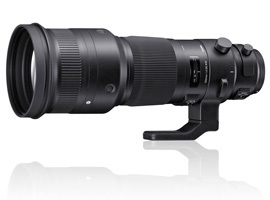


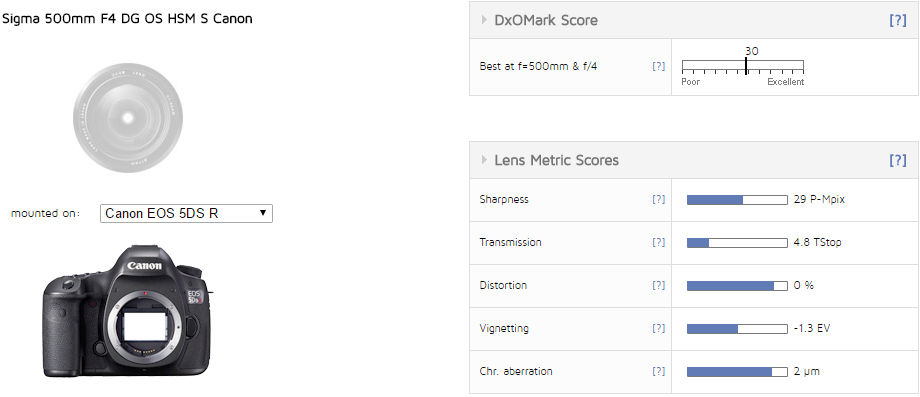



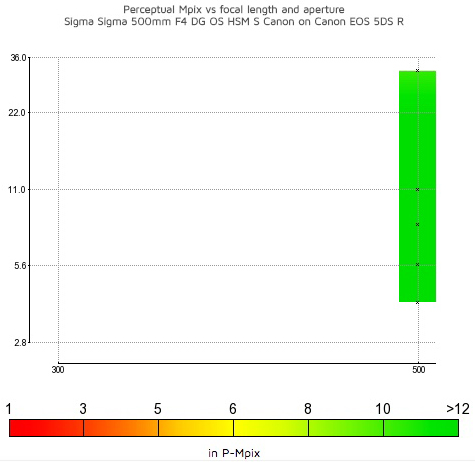


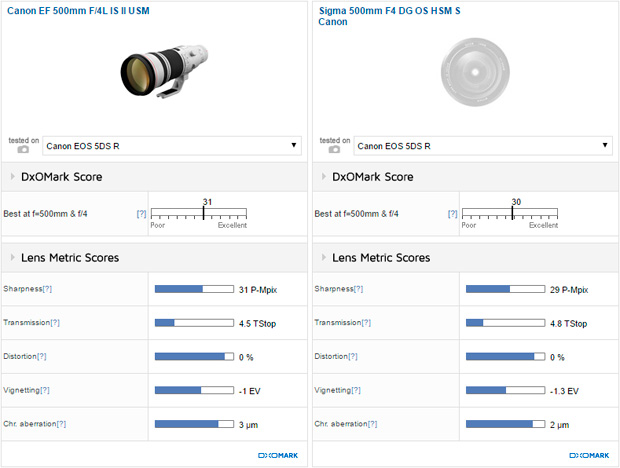

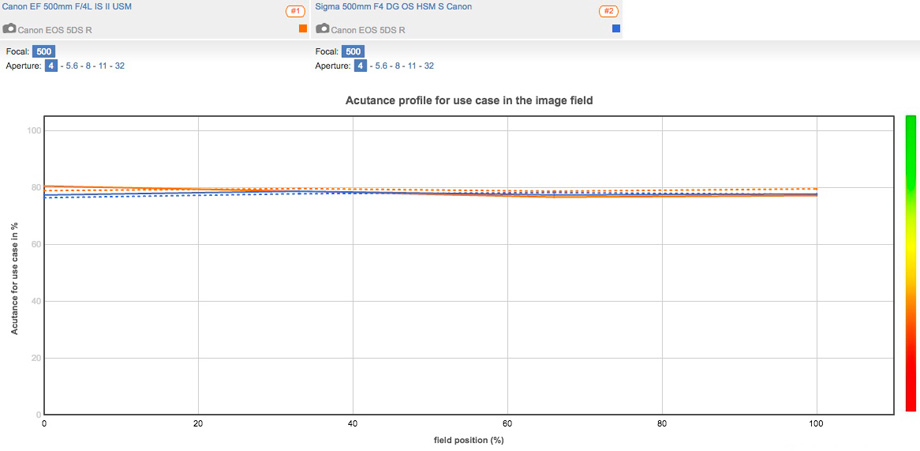
DXOMARK encourages its readers to share comments on the articles. To read or post comments, Disqus cookies are required. Change your Cookies Preferences and read more about our Comment Policy.